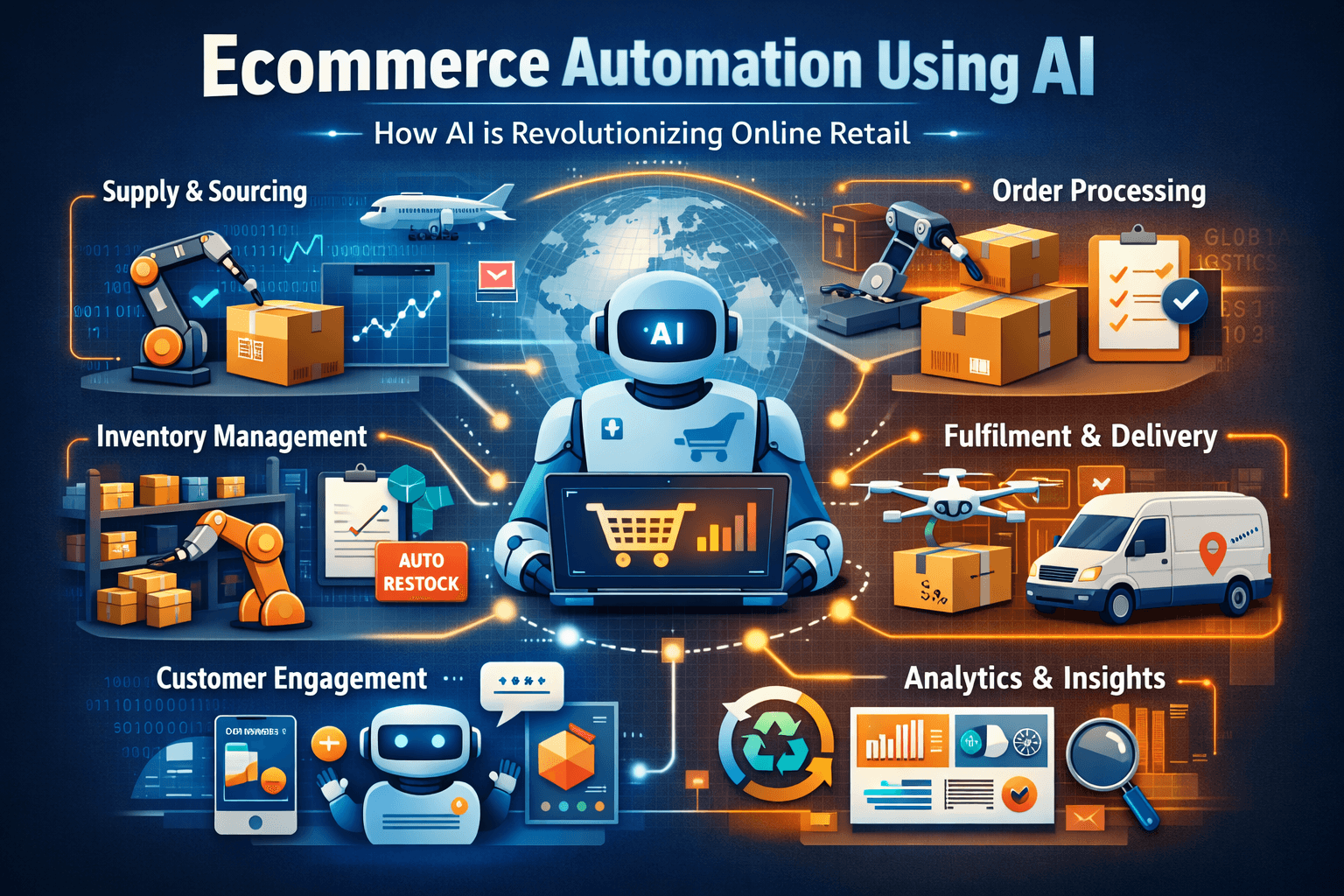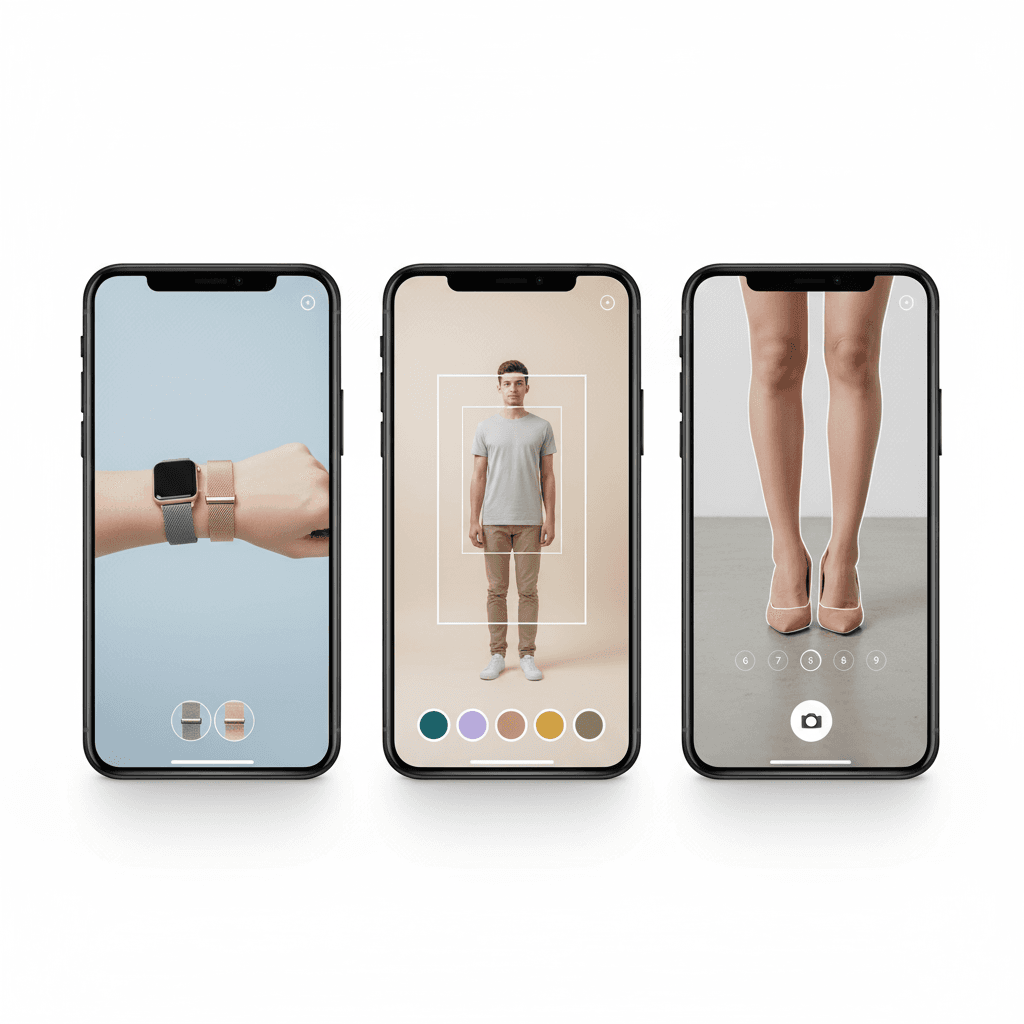How Augmented Reality Retail Shopping Is Changing Fashion?
AI in Retail: How It's Revolutionizing Shopping in 2025


TL;DR
AI is rapidly transforming retail in 2025 by enabling personalization, smarter inventory and pricing, immersive experiences, and improved fraud protection. Retailers embracing AI gain competitive advantage, while shoppers enjoy tailored, faster, and more convenient experiences. But success depends on ethical, transparent implementation and effective change management.
Introduction: The Rise of AI in Retail
The way we shop is changing faster than ever — and AI in retail is leading the charge. From personalized recommendations popping up when you unlock your phone, to dynamic pricing that shifts in real time, artificial intelligence is transforming retail into something more intuitive, responsive, and personal.
Today, retail isn’t just about shelves and shopping carts — it’s about smart algorithms working quietly in the background to predict what you want, when you want it, and how you prefer to buy it. Whether you’re browsing online, using an AI-powered app like Glance AI, or walking into a store with a smart mirror, AI is woven into every step of the shopping journey.
In this guide, we break down what AI in retail really means, why it’s more important than ever in 2025, and how businesses and shoppers alike are benefiting from this new era of smart, human-centric commerce.
What Is AI in Retail?

What Is AI in Retail — And Why Does It Matter Now?
AI in retail means using intelligent technologies — like machine learning, predictive analytics, computer vision, and conversational bots — to make shopping better for both retailers and customers.
For businesses, it’s about taking massive amounts of customer data — browsing history, purchase patterns, even weather trends — and turning it into real-time actions: smarter inventory, more accurate demand forecasts, tailored promotions, and instant service.
For shoppers, AI in retail means you don’t waste time scrolling through irrelevant products. Instead, you get curated suggestions, helpful chatbots, virtual try-ons, and personalized offers that match your style, size, and taste — sometimes before you even search.
This shift is huge because modern shoppers expect more: convenience, speed, personalization, and a seamless experience whether they’re on an app like Glance AI, shopping in-store, or browsing on social media. AI makes it all possible — and businesses that adopt it now will set the pace for the future.
Why AI in Retail Is Growing So Fast
Retail has always evolved to match customer expectations. But the last few years have changed everything: eCommerce boomed, lockdowns shifted how we shop, and customers now expect instant personalization and frictionless buying experiences.
AI in retail answers this demand. It uses huge datasets, machine learning, and predictive intelligence to remove guesswork, deliver hyper-personalized recommendations, and automate tasks once handled manually.
According to Grand View Research, the U.S. AI in retail market generated USD 2,325.3 million in 2024 and is projected to reach USD 4,851.9 million by 2030, growing at a CAGR of ~12.3%.
In 2025, AI in retail is a competitive necessity — not a nice-to-have.
Key Applications: How AI in Retail Is Changing Shopping

So how does this all come together in the real world? Let’s explore the practical ways AI in retail is transforming shopping.
1️. Personalized Recommendations & Styling
One of the most visible uses of AI in retail is personalized shopping. Algorithms analyze your past purchases, browsing patterns, and wishlist items to recommend products that fit your style.
For example, Glance AI, an AI-powered shopping app, delivers fashion ideas and product suggestions directly on your smartphone lock screen. This makes product discovery feel natural — you don’t have to search; inspiration finds you.
2️. Smart Inventory & Demand Forecasting
Retailers hate overstock and out-of-stock problems. AI in retail uses predictive analytics to match stock levels with demand. It factors in seasonality, local events, and even weather patterns.
This keeps shelves stocked with what shoppers want — no more guessing games.
According to the NVIDIA “State of AI in Retail and CPG” report, 53% of U.S. retailers (especially larger ones) are using AI for store insights (e.g. queue analytics, footfall) already.
3️. Dynamic Pricing
Prices don’t have to stay static. AI in retail adjusts prices dynamically based on demand, competitor pricing, and inventory. That means shoppers get competitive prices, and retailers maximize margins in real-time.
4️. Conversational Commerce & Virtual Assistants
Chatbots and voice assistants are mainstream now. AI in retail powers these tools to help shoppers find products, answer questions, or guide them through checkout 24/7.
Customers get instant support — retailers save on overheads.
5️. AR, VR & IoT: The Rise of Immersive Retail
AI brings shopping to life through AR and VR. Virtual fitting rooms let you see clothes on your body before you buy. Smart mirrors recommend outfits in-store. IoT sensors track foot traffic and optimize store layouts.
Brands like Sephora use AR to let shoppers try makeup virtually — boosting confidence to buy online.
6️. Fraud Prevention & Security
Every second, AI in retail analyzes transactions to spot unusual patterns. This reduces fraud while minimizing false alarms. Biometric checks, multi-factor authentication, and real-time risk scoring protect both retailers and shoppers.
Types of AI Used in Retail
AI isn’t a single technology—it’s a toolbox of intelligent systems. Here are the main types transforming retail:
- Predictive AI: Analyzes historical data to forecast future outcomes, such as product demand, customer behavior, or market trends. This helps retailers make proactive decisions that save money and improve service.
- Prescriptive AI: Goes a step further than predictive models by recommending specific actions, such as optimal pricing strategies, discounting windows, or inventory redistribution.
- Conversational AI: Powers chatbots and voice assistants that can answer questions, suggest products, or process orders—providing real-time support across multiple channels.
- Generative AI: Creates entirely new content, including product descriptions, campaign visuals, and social media ads. It also powers tools like AI stylists that can create new looks and collections.
Core Technologies Behind AI in Retail
The power of AI in retail comes from a strong tech foundation. Here's a deeper look at the key technologies:
- Machine Learning (ML): It’s the core of AI systems—these algorithms learn from historical data and continuously improve decision-making, such as forecasting demand or optimizing supply chains.
- Natural Language Processing (NLP): Enables systems to understand, interpret, and generate human language. In retail, it’s used in search engines, chatbots, and customer sentiment analysis.
- Computer Vision: Helps machines process and interpret visual inputs. Retailers use it for shelf analysis, product tagging, AR fitting rooms, and visual searches.
- Big Data: AI feeds on data. From transactions to customer journeys, big data platforms organize massive datasets that fuel personalization and prediction.
- Generative AI: Beyond automation, this tech creates new content—from marketing copy and images to fully styled outfit suggestions—offering new creative possibilities for retail engagement.
AI Tools & Platforms Retailers Use
To implement AI in retail, brands use robust platforms. Some big players in 2025:
- Glance AI: Delivers daily personalized fashion inspiration on smartphones.
- Salesforce Einstein: Adds AI insights to CRM for smarter campaigns.
- Google Cloud Retail AI: Enables visual search, forecasting, and personalization.
- IBM Watson Commerce: Powers smart supply chain and customer analytics.
Vue.ai: AI styling and visual tagging for fashion retailers.
Best Practices for Using AI in Retail
Jumping into AI in retail takes strategy. Here’s how brands do it right:
- Start Small, Scale Smart
Begin with clear goals — like improving recommendations or streamlining inventory. Test, measure, and expand. - Clean Your Data
Bad data = bad results. Maintain organized, updated datasets. - Train Teams
Invest in upskilling staff to use AI insights well. - Be Transparent
Tell shoppers how their data is used. Offer easy opt-outs for personalization. - Monitor & Improve
AI models aren’t “set and forget.” They need regular updates to stay relevant and fair.
Real-World Examples: Who’s Doing It Well?
Brand | AI in Retail Example | Result |
| Amazon | Predictive product suggestions | Higher repeat purchases |
| Walmart | AI demand forecasting | Lower stockouts |
| Sephora | AR beauty try-ons | Better online conversions |
| Glance AI | Mobile-first style discovery | Effortless product finds |
| Target | Dynamic pricing AI | Competitive edge during sales |
Real-Time Retail: AI That Adapts Instantly
Today’s shoppers expect real-time interaction. AI makes it possible:
- Live Personalization: Shoppers see different homepage layouts, content, or offers based on their activity.
- Triggered Campaigns: AI launches flash sales or product pushes based on sudden demand spikes.
- Trend Response: AI picks up on social media and pop culture trends, recommending matching products instantly.
According to Salesforce’s Connected Shoppers Report, 43% of U.S. retailers are actively piloting autonomous AI, while another 53% are evaluating its use.
Glance AI enhances this by presenting relevant looks and products on smartphones, ensuring discovery happens naturally and effortlessly.
AI vs Traditional Retail: A Comparison
Feature | Traditional Retail | AI-Powered Retail |
Decision-making | Manual, experience-based | Automated, real-time, data-driven |
Personalization | Generic offers | Hyper-personalized experiences |
Inventory Management | Reactive (post-issue) | Predictive and proactive |
Customer Support | Limited to working hours | Always-on AI support across channels |
AI in Retail: Benefits for Brands & Shoppers
Why retailers love AI in retail:
- Higher conversion rates
- Smarter stock levels
- Optimized pricing
- Better marketing ROI
Why shoppers love AI in retail:
- Personal recommendations save time
- Better deals with dynamic pricing
- Instant support via chatbots
- Try-before-you-buy with AR
Challenges of Adopting AI in Retail
Adoption isn't always easy. Key roadblocks include:
- Data Privacy Concerns: Consumers want clarity and control over how their data is used.
- Bias and Fairness: Poor training data can lead to biased outcomes. Retailers must audit and monitor algorithms.
- Upfront Costs: AI tools, training, and integration can be expensive for small to mid-size retailers.
- Cultural Resistance: Some employees may fear automation or lack skills to adapt to AI-powered systems.
According to SAP Emarsys, 92% of U.S. retail marketers say they are using AI in 2025, and 55% of U.S. retail marketers plan to increase their AI investment to boost engagement.
Glance AI: Redefining Personalized Shopping
Glance AI is redefining how people discover fashion and products in today’s mobile-first world. It offers a seamless, immersive shopping experience that is powered by real-time, AI-generated styling and discovery. By analyzing trends, user preferences, and contextual behavior, Glance AI curates personalized looks and product suggestions—helping users find inspiration instantly.
What makes Glance AI stand out is its ability to integrate product discovery into a consumer’s daily digital behavior. With minimal friction, users are introduced to new trends, seasonal styles, and tailored recommendations. Whether someone is exploring boho fashion, retro revivals, or streetwear staples, Glance AI learns and evolves with their unique tastes.
Key Highlights of Glance AI:
- AI-powered daily style curation and inspiration
- Instant access to product suggestions across categories
- Real-time visual storytelling that aligns with trends
- A discovery-first approach to commerce
- Seamless integration into users’ mobile behavior
Glance makes shopping feel less transactional and more experiential—where inspiration and action are tightly linked.
Ethics & Responsible AI in Retail
- As AI in retail grows, so does responsibility. Brands must handle data ethically, protect privacy, and reduce bias. Responsible AI means:
- Clear opt-outs
Transparent policies
Regular audits for fairness
Strong security - Retailers that balance innovation with trust build loyal customers.
What’s Next: The Future of AI in Retail

Here’s what’s on the horizon:
- Voice & Gesture Shopping: Navigate, search, and shop using speech or hand gestures.
- AI Fashion Stylists: Receive daily looks, outfit curation, and style feedback from generative AI.
- Sustainable AI Tools: Forecast demand better to reduce overproduction and waste.
- AR/VR Shopping: Try clothes, furniture, and makeup in a virtual space before buying.
- Autonomous Stores: Unmanned stores with AI handling payments, inventory, and security.
- Hyperlocal Personalization: AI will adapt not just to individuals, but also their location, weather, events, and real-time context.
- Multimodal Discovery: Users will interact with AI through text, images, gestures, and even emotion detection—making shopping feel intuitive, conversational, and human.
- According to Precedence Research, the study estimates the U.S. AI in retail market was about USD 3.26 billion in 2024 and is expected to reach USD 18.19 billion by 2034, at a CAGR of ~18.76%.
Conclusion
Retail isn’t just about transactions—it’s about delivering value, personalization, and inspiration at every touchpoint. AI empowers retailers to do this with unprecedented speed, scale, and precision. As we move toward a future shaped by generative AI, real-time decision-making, and immersive discovery, brands that embrace intelligent retail will outpace their competition.
Glance AI exemplifies this shift, pioneering a retail model where product discovery is effortless, personal, and aligned with everyday digital behavior. The future of shopping is not only smarter—it’s more human, contextual, and engaging.
AI isn’t just powering the next chapter of retail—it’s writing the rules. The time to adopt is now.
FAQs
Q: What is AI in retail?
A: AI in retail refers to using data driven technologies such as machine learning, predictive analytics, and natural language processing to make shopping more efficient, personalized, and profitable. Retailers apply it across the customer and operational lifecycle, from forecasting demand and managing inventory to tailoring product recommendations, automating service interactions, preventing fraud, improving pricing decisions, and planning store layouts. It supports both ecommerce and physical stores, helping retailers reduce costs, increase conversions, and deliver experiences that feel relevant and timely.
Q: How does AI in retail help small businesses?
A: AI in retail helps small businesses use data and automation to work smarter. It improves demand forecasting, prevents stockouts, supports accurate pricing, and reduces manual tasks. AI also personalizes marketing, answers customer queries, and guides product recommendations, helping local retailers increase loyalty, compete confidently, and grow without large teams or budgets.
Q: Is customer data safe?
A: Customer data is never completely risk free, but it can be well protected when businesses use encryption, strict access controls, regular security audits, and comply with privacy laws like GDPR and CCPA. Strong governance, transparent data practices, and rapid response to threats significantly reduce the chance of misuse or breaches.
Q: What makes Glance AI different?
A: It delivers real-time styling and product discovery directly on your smartphone — no search needed.






